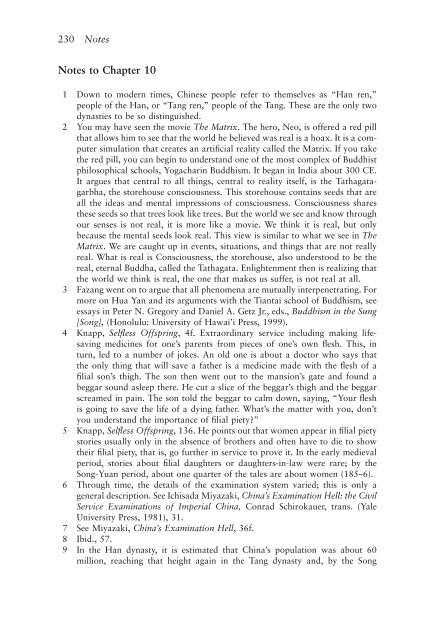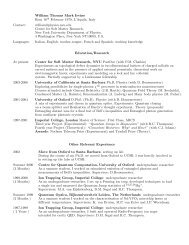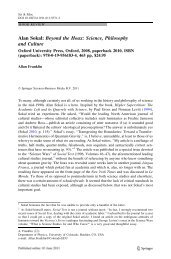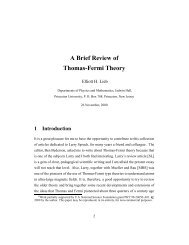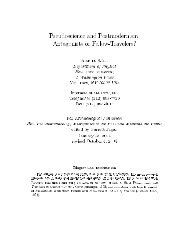Good Confucianism book (pdf) - Department of Physics
Good Confucianism book (pdf) - Department of Physics
Good Confucianism book (pdf) - Department of Physics
You also want an ePaper? Increase the reach of your titles
YUMPU automatically turns print PDFs into web optimized ePapers that Google loves.
230 NotesNotes to Chapter 101 Down to modern times, Chinese people refer to themselves as “ Han ren, ”people <strong>of</strong> the Han, or “ Tang ren, ” people <strong>of</strong> the Tang. These are the only twodynasties to be so distinguished.2 You may have seen the movie The Matrix . The hero, Neo, is <strong>of</strong>fered a red pillthat allows him to see that the world he believed was real is a hoax. It is a computersimulation that creates an artificial reality called the Matrix. If you takethe red pill, you can begin to understand one <strong>of</strong> the most complex <strong>of</strong> Buddhistphilosophical schools, Yogacharin Buddhism. It began in India about 300 CE.It argues that central to all things, central to reality itself, is the Tathagata -garbha, the storehouse consciousness. This storehouse contains seeds that areall the ideas and mental impressions <strong>of</strong> consciousness. Consciousness sharesthese seeds so that trees look like trees. But the world we see and know throughour senses is not real, it is more like a movie. We think it is real, but onlybecause the mental seeds look real. This view is similar to what we see in TheMatrix . We are caught up in events, situations, and things that are not reallyreal. What is real is Consciousness, the storehouse, also understood to be thereal, eternal Buddha, called the Tathagata. Enlightenment then is realizing thatthe world we think is real, the one that makes us suffer, is not real at all.3 Fazang went on to argue that all phenomena are mutually interpenetrating. Formore on Hua Yan and its arguments with the Tiantai school <strong>of</strong> Buddhism, seeessays in Peter N. Gregory and Daniel A. Getz Jr., eds., Buddhism in the Sung[Song] , (Honolulu: University <strong>of</strong> Hawai ’ i Press, 1999).4 Knapp, Selfless Offspring , 4f. Extraordinary service including making life -saving medicines for one ’ s parents from pieces <strong>of</strong> one ’ s own flesh. This, inturn, led to a number <strong>of</strong> jokes. An old one is about a doctor who says thatthe only thing that will save a father is a medicine made with the flesh <strong>of</strong> afilial son ’ s thigh. The son then went out to the mansion ’ s gate and found abeggar sound asleep there. He cut a slice <strong>of</strong> the beggar ’ s thigh and the beggarscreamed in pain. The son told the beggar to calm down, saying, “ Your fleshis going to save the life <strong>of</strong> a dying father. What ’ s the matter with you, don ’ tyou understand the importance <strong>of</strong> filial piety? ”5 Knapp, Selfless Offspring , 136. He points out that women appear in filial pietystories usually only in the absence <strong>of</strong> brothers and <strong>of</strong>ten have to die to showtheir filial piety, that is, go further in service to prove it. In the early medievalperiod, stories about filial daughters or daughters - in - law were rare; by theSong - Yuan period, about one quarter <strong>of</strong> the tales are about women (185 – 6).6 Through time, the details <strong>of</strong> the examination system varied; this is only ageneral description. See Ichisada Miyazaki, China ’ s Examination Hell: the CivilService Examinations <strong>of</strong> Imperial China, Conrad Schirokauer, trans. (YaleUniversity Press, 1981 ), 31.7 See Miyazaki, China ’ s Examination Hell , 36f.8 Ibid., 57.9 In the Han dynasty, it is estimated that China ’ s population was about 60million, reaching that height again in the Tang dynasty and, by the Song


